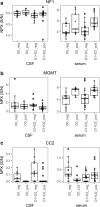Protein Profiling in Serum and Cerebrospinal Fluid Following Complex Surgery on the Thoracic Aorta Identifies Biological Markers of Neurologic Injury
- PMID: 30367354
- PMCID: PMC6294830
- DOI: 10.1007/s12265-018-9835-8
Protein Profiling in Serum and Cerebrospinal Fluid Following Complex Surgery on the Thoracic Aorta Identifies Biological Markers of Neurologic Injury
Abstract
Surgery on the arch or descending aorta is associated with significant risk of neurological complications. As a consequence of intubation and sedation, early neurologic injury may remain unnoticed. Biomarkers to aid in the initial diagnostics could prove of great value as immediate intervention is critical. Twenty-three patients operated in the thoracic aorta with significant risk of perioperative neurological injury were included. Cerebrospinal fluid (CSF) and serum were obtained preoperatively and in the first and second postoperative days and assessed with a panel of 92 neurological-related proteins. Three patients suffered spinal cord injury (SCI), eight delirium, and nine hallucinations. There were markers in both serum and CSF that differed between the affected and non-affected patients (SCI; IL6, GFAP, CSPG4, delirium; TR4, EZH2, hallucinations; NF1). The study identifies markers in serum and CSF that reflect the occurrence of neurologic insults following aortic surgery, which may aid in the care of these patients.
Keywords: Biomarkers; Cardiovascular surgery; Neurologic injury; Thoracic aortic disease.
Conflict of interest statement
Conflict of Interest
UL has a significant ownership interest as founder of, and stock holder in, Olink Proteomics, developing the protein assays used herein. All other authors have no conflict of interest to declare.
Ethical Approval
All procedures performed in studies involving human participants were in accordance with the ethical standards of the institutional and/or national research committee and with the 1964 Helsinki declaration and its later amendments or comparable ethical standards.
Informed Consent
Informed consent was obtained from all individual participants included in the study. This article does not contain any studies with animals performed by any of the authors.
Figures




Similar articles
-
The role of cerebrospinal fluid S100 and lactate to predict clinically evident spinal cord ischaemia in thoraco-abdominal aortic surgery.Eur J Vasc Endovasc Surg. 2008 Jul;36(1):11-9. doi: 10.1016/j.ejvs.2008.01.011. Epub 2008 Mar 3. Eur J Vasc Endovasc Surg. 2008. PMID: 18313337 Clinical Trial.
-
Cerebrospinal Fluid Biomarkers To Stratify Injury Severity and Predict Outcome in Human Traumatic Spinal Cord Injury.J Neurotrauma. 2017 Feb;34(3):567-580. doi: 10.1089/neu.2016.4435. Epub 2016 Aug 15. J Neurotrauma. 2017. PMID: 27349274 Clinical Trial.
-
Embolism is emerging as a major cause of spinal cord injury after descending and thoracoabdominal aortic repair with a contemporary approach: magnetic resonance findings of spinal cord injury.Interact Cardiovasc Thorac Surg. 2014 Aug;19(2):205-10. doi: 10.1093/icvts/ivu148. Epub 2014 May 14. Interact Cardiovasc Thorac Surg. 2014. PMID: 24827461
-
Neurological complications of thoracic endovascular aortic repair.Semin Cardiothorac Vasc Anesth. 2011 Dec;15(4):123-40. doi: 10.1177/1089253211424224. Epub 2011 Oct 24. Semin Cardiothorac Vasc Anesth. 2011. PMID: 22025398 Review.
-
Potential diagnostic and prognostic value of serum and cerebrospinal fluid biomarkers in traumatic spinal cord injury: A systematic review.J Neurochem. 2019 May;149(3):317-330. doi: 10.1111/jnc.14637. Epub 2019 Jan 15. J Neurochem. 2019. PMID: 30488446
Cited by
-
Intermediate outcomes following arch reconstruction with frozen elephant trunk, a single centre study.J Cardiothorac Surg. 2023 Jan 22;18(1):44. doi: 10.1186/s13019-023-02140-5. J Cardiothorac Surg. 2023. PMID: 36683042 Free PMC article.
-
Accumulating the key proteomic signatures associated with delirium: Evidence from systematic review.PLoS One. 2024 Dec 19;19(12):e0309827. doi: 10.1371/journal.pone.0309827. eCollection 2024. PLoS One. 2024. PMID: 39700095 Free PMC article.
-
Blood GFAP as an emerging biomarker in brain and spinal cord disorders.Nat Rev Neurol. 2022 Mar;18(3):158-172. doi: 10.1038/s41582-021-00616-3. Epub 2022 Feb 3. Nat Rev Neurol. 2022. PMID: 35115728 Review.
-
Intraoperative plasma proteomic changes in cardiac surgery: In search of biomarkers of post-operative delirium.Proteomics Clin Appl. 2023 Jul;17(4):e2200066. doi: 10.1002/prca.202200066. Epub 2023 Jan 4. Proteomics Clin Appl. 2023. PMID: 36567636 Free PMC article.
-
Near-Infrared Spectroscopy Monitoring in Cardiac and Noncardiac Surgery: Pairwise and Network Meta-Analyses.J Clin Med. 2019 Dec 14;8(12):2208. doi: 10.3390/jcm8122208. J Clin Med. 2019. PMID: 31847312 Free PMC article.
References
-
- Al Tmimi, L., et al. (2016). Serum protein S100 as marker of postoperative delirium after off-pump coronary artery bypass surgery: secondary analysis of two prospective randomized controlled trials. Clinical Chemistry and Laboratory Medicine. 10.1515/cclm-2015-1012. - PubMed
-
- Badhiwala, J. H., Wilson, J. R., Kwon, B. K., Casha, S., & Fehlings, M. G. (2018). A review of clinical trials in spinal cord injury including biomarkers. Journal of Neurotrauma. 10.1089/neu.2018.5935. - PubMed
Publication types
MeSH terms
Substances
LinkOut - more resources
Full Text Sources
Research Materials
Miscellaneous

